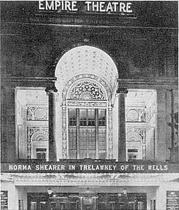day by day: a blog
March 12, 2009
dating the death of the heart
 [image: The Empire Cinema, Leicester Square, 1928]
[image: The Empire Cinema, Leicester Square, 1928]
Near the start of Elizabeth Bowen's The Death of the Heart, Thomas and Anna Quayne and Anna's teenage step-sister, Portia Quayne, go one evening to see a Marx Brothers "movie" (the preferred term for a "film" in 1930s England) at the giant, 3,000-seat Empire Cinema in Leicester Square. The serious, uncynical Portia does not enjoy the slapstick wisecracking. "The screen," Bowen writes, "threw its tricky light onto her unrelaxed profile." When the main feature is over, at once the "three Quaynes dived for their belongings and filed silently out -- they missed the News in order to miss the Rush."
Such indifference, even at times of great historical crisis, is neither uncommon or surprising. The trivial Thomas and Anna maintain a self-absorbed, expensively insular existence, their privacy "surrounded by an electric fence." What is the "News" to them? What is "History"? And, to go further, what is "History" to Bowen's novel with its apparently rigorous privileging of domestic and emotional dilemmas over participation in, or thought about the meaning of, public events? Is the novel as damagingly bourgeois in its purview as some of the novel's main characters are in theirs?
Bowen is obsessed by time in the book: dates, days, months, seasons are all carefully articulated; the plot's chronology is exquisitely modulated and manipulated with an almost heavy-handed "air of authority". But the novelist appears to maintain a calculated silence about the book's historical mooring. She seems to exercise a rigorous exclusion of historical reference. Dates, days, months, seasons all recur; but years, in Bowen's book, do not. Why not tell us when the events takes place? Why not allow us to anchor The Death of the Heart in the social world, in history?
In fact, without ever clearly mentioning the year in which the book's events happen, Bowen did obliquely tell readers when they occurred. And it is typical of this hyper-mandarin novel's deep-seated idiosyncracy that she should have done so by means of a reference to popular culture.
Only two Marx Brothers films opened at the Empire Cinema in London in the 1930s -- A Night at the Opera and A Day at the Races. But the Quaynes and Portia visit the Empire (where the campy Canadian musician Sandy Macpherson, 1897-1975, who is mentioned with irritation by Anna, was the resident organist between 1928 and 1938) during a dark, cold part of the year. The women are wearing fur collars that night. So they cannot have watched A Day at the Races, which opened in Britain in August 1937. Thomas, Anna and Portia must have seen A Night at the Opera which opened at the Empire at the start of March 1936. (The Times's supercilious review of the Brothers' "sub-human antics" is "New Films in London", Times, 2 March 1936, p. 12.)
It is a wry, wearily-sophisticated little joke on Bowen's part that she deploys "Marx", albeit not Karl Marx, to place The Death of the Heart in a historical setting. But in so fastidiously planting a single clue to the dating of her book, Bowen decisively pivoted the novel into real time, into history. A couple of months after The Death of the Heart was published in October 1938, E. M. Forster commented approvingly that "from the artistic point of view" Bowen's fiction was "the best novel of the year." Forster's surface meaning in calling the book the "best novel of the year" was that The Death of the Heart appeared to him the most accomplished novel published in 1938. But he was also, simultaneously but more quietly, declaring that The Death of the Heart was the "best novel" about a particular year. And that year was 1936.
Once the ciphered historical reference point in Bowen's novel is decrypted, all of its private events become tinted differently as if from a new light source. "Everyone in England is waiting for the war to start", W. H. Auden told his brother in a letter written on 24 February 1936 within a few days of Portia and the Quaynes' fictional visit to the Empire Cinema. Subliminally, all the characters in The Death of the Heart are waiting for the war. Nothing, even of the most intimate, private kind, happens in the book that is not illuminated, or darkened, by largely unspoken anxieties about public events and the "collapsing society" Forster identified.
By allowing the beams projecting from a real screening booth to fall just momentarily onto her fictional page, Elizabeth Bowen let politics and war throw their tricky lights all across a young girl's profile. This obsessive, inescapable watching and waiting for a future without a shape are what lived, collectively-shared experience felt like in Britain in 1936. The atmospheres of exhaustion, malice and dread in The Death of the Heart are created as much by the pressure of events as they are by corrupted individuals. The novel's mournful poetry -- as Bowen indicated through a passing topical reference to a comedy -- is historical.
Posted by njenkins at March 12, 2009 06:26 PM
With the exception of interspersed quotations, all writing is © 2007-09 by Nicholas Jenkins